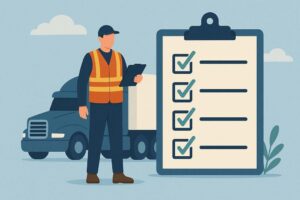In this article, you’ll learn exactly how to comply with FMCSA’s Entry-Level Driver Training (ELDT) rules to avoid costly penalties and ensure your fleet stays compliant.
How to Meet FMCSA CDL Training Rules & Avoid Penalties
Background
On February 7, 2022, the Federal Motor Carrier Safety Administration (FMCSA) implemented new Entry-Level Driver Training (ELDT) regulations that set a national baseline for driver training standards. These regulations apply to individuals seeking to obtain a Class A or Class B Commercial Driver’s License (CDL) for the first time, upgrade an existing Class B CDL to a Class A CDL, or add a school bus (S), passenger (P), or hazardous materials (H) endorsement for the first time. These regulations are now the standard for Entry-Level Driver Training requirements. To meet these requirements, individuals must complete training through a provider listed on the FMCSA’s Training Provider Registry (TPR).
Grandfather Clause: Drivers who held a valid CDL or the endorsements listed above before February 7, 2022, are not subject to these requirements.
Military Waiver Exception: Veterans with experience driving military CMVs may be able to waive the official state knowledge test and will not be subject to ELDT requirements.
Why ELDT Compliance Matters
To ensure compliance with ELDT requirements, the Federal Motor Carrier Safety Administration (FMCSA) established CDL training rules and created the Training Provider Registry (TPR), an online database of certified providers that meet the federal standards.
If you train your drivers in-house, you are your own training provider. As such, you must comply with all ELDT requirements on training providers:
- Design your own ELDT curriculum.
- Get registered on TPR as a training provider.
- For each driver who completes ELDT training, you must report it within two business days.
If your chosen training provider (which could be yourself if training in-house) is not compliant with ELDT requirements, you and your training provider may face these penalties:
- Removal of the training provider from TPR.
- Drivers the provider trained may be disqualified from obtaining CDLs.
- You may face an FMCSA audit.
- You may face a fine of at least $11,000 per violation.
If you are not compliant with ELDT requirements, you may face these penalties:
- Your State Driver Licensing Agency (SDLA) may reject your drivers’ CLP or CDL applications or prevent them from taking required tests.
- The FMCSA will note the violations in the “Driver Fitness” metric of your CSA safety score. This may lead to your overall CSA safety score being downgraded.
- Repeated violations may result in the FMCSA suspending or even revoking your operating authority.
- Because SDLAs must verify an applicant’s training through the TPR before allowing them to take CDL skills or knowledge tests, it is critical to ensure you (or your training provider) are listed and compliant. You can search for registered training providers by visiting this website: https://tpr.fmcsa.dot.gov/.
Two Core Components of ELDT
The ELDT program is divided into two major training components: Theory Instruction and Behind-the-Wheel (BTW) Training.
- Theory Instruction
- Covers basic operation, safe operating procedures, advanced operating practices, vehicle systems, non-driving activities, trip planning, Hours of Service, and more.
- May be conducted in a classroom or online.
- No minimum number of hours required, but the trainees must score at least 80% on assessments.
- ELDT theory includes some topics not covered in typical official state CDL manuals. It’s no longer enough to just “train to the manual.”
- Behind-the-Wheel (BTW) Training
- Involves operation of a commercial motor vehicle (CMV) on a range and public roads.
- Focuses on basic vehicle control and mastery of maneuvers.
- No minimum hours, but drivers must be deemed proficient in all skills.
- Must be done in the same type of vehicle for which the CDL is sought. (Simulators cannot replace actual BTW training.)
- Conduct Periodic Internal Audits
- Schedule regular compliance reviews (e.g., quarterly or biannually) to ensure documentation is up to date.
- Compare your training curriculum against 49 CFR Part 380 to confirm no new federal updates have been missed.
- Standardize Record-Keeping
- Use a centralized digital storage system for driver training records.
- Create a consistent naming convention for documents (e.g., “LastName_FirstName_TrainingDate”).
- Ensure all instructor qualifications are renewed on time and logs are updated with each new hire or training session.
- Proactively Plan for State-Level Nuances
- While federal guidelines provide the baseline, some states may have additional requirements (e.g., background checks or extended training hours for specific endorsements).
- Keep track of state deadlines or unique mandates, especially if you operate in multiple states.
- Stay Current on FMCSA Announcements
- Subscribe to FMCSA newsletters or press releases to stay updated on changes to federal regulations.
- Follow industry associations such as ATA (American Trucking Associations) for policy alerts.
- If you’re using or have used an external training provider, re-verify its status every 90 days to ensure that FMCSA took no actions against it in the meantime.
- If you’re training in-house, you are your own ELDT-compliant training provider. As such, if you change your address or phone number, you must submit an updated ELDT Registration form within 30 days.
- Prepare for Audits
- Have digital and physical copies of key documents, such as instructor credentials, curriculum outlines, test scores, and training logs.
- Conduct internal “mock audits” to spot gaps or inconsistencies before a real DOT audit occurs.
- Educate Your Team
- Host periodic training for safety managers, dispatchers, and HR personnel to ensure everyone understands the latest ELDT rules.
- Consider “train-the-trainer” sessions so that multiple team members can handle compliance if someone is out of the office.
- Comprehensive CDL Test Preparation: Access to up-to-date practice tests and study materials aligned with FMCSA guidelines.
- Progress Tracking & Reporting: Easily track each driver’s progress and test results to streamline record-keeping.
- Multi-User Management: Add and remove drivers or training coordinators quickly; keep everyone accountable with assigned modules.
- Engaging Mobile-Friendly Content: Drivers can study on their own schedule, reducing classroom time and improving pass rates.
Corporate ELDT Compliance Checklist
ELDT compliance is essential for organizations training new commercial drivers under the FMCSA regulations. The following checklist is based on the US Department of Transportation Federal Motor Carrier Association’s published material:
1. Curriculum Compliance
– Align training with 49 CFR Part 380, Appendices A–E
– Include both theory and behind-the-wheel (BTW) components
– Student drivers must complete full ELDT before taking the official skills test for their CDL
2. Instructor Qualifications
– Instructors must hold a valid CDL of equal or higher class
– Minimum of 2 years of relevant driving or BTW instruction experience
3. Facilities & Equipment
– Classrooms and ranges meet federal, state, and local standards
– Training vehicles match the type used for CDL testing and meet safety regulations
4. State Licensing
– Hold required licenses or authorizations in all states of operation
5. Record-Keeping (Retain for 3 Years)
– Self-certifications for BTW training
– Copies of CLPs/CDLs
– Instructor qualifications
– Theory & BTW lesson plans
– Driver assessment records
6. Training Provider Registry (TPR)
– Register with FMCSA’s TPR
– Self-certify compliance (required even if not public-facing)
7. Certification Submission
– Report completion to TPR by midnight of the 2nd business day after training ends
Practical Tips for Staying Compliant
How Driving-Tests.org Can Help You Simplify ELDT Compliance
Meeting ELDT requirements can feel overwhelming – especially if you manage multiple new hires and endorsements. Driving-Tests.org’s CDL Premium Corporate platform provides:
By integrating proven online learning tools with practical test prep, you free up your instructors to focus on the hands-on portion of ELDT – while still meeting FMCSA’s theory requirements.
References
Federal Motor Carrier Safety Administration. (n.d.). Entry-level driver training (ELDT). U.S. Department of Transportation. Retrieved April 10, 2025, from https://www.fmcsa.dot.gov/registration/commercial-drivers-license/entry-level-driver-training-eldt
Federal Motor Carrier Safety Administration. (n.d.). Training Provider Registry (TPR). U.S. Department of Transportation. Retrieved April 10, 2025, from https://tpr.fmcsa.dot.gov/
Federal Motor Carrier Safety Administration. (n.d.). ELDT curriculum summary. U.S. Department of Transportation. Retrieved April 10, 2025, from https://tpr.fmcsa.dot.gov/content/Resources/ELDT-Curriculum-Summary.pdf
Federal Motor Carrier Safety Administration. (n.d.). Countdown to ELDT implementation: Training provider checklist. U.S. Department of Transportation. Retrieved April 10, 2025, from https://tpr.fmcsa.dot.gov/content/Resources/Countdown-to-ELDT-training-provider-2023.pdf



